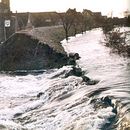New Protection Concepts for the North Sea Coast
Hydraulic engineers at the University of Siegen are working on early warning systems for storm surges as part of the “EarlyDike” project
In the past, storm surge disasters have repeatedly caused immense damage along the German coast. For example, the 1962 storm surge in Hamburg claimed the lives of more than 300 victims. Appropriate early warning systems for forecasting water levels can be used to respond to these type of dangers in good time by, for example, initiating an evacuation of the affected area.
Scientists at the Research Institute for Water and Environment at the University of Siegen headed by Prof. Dr.-Ing. Jürgen Jensen in the Civil Engineering Department are participating on the development of this type of early warning system. As part of a joint project organised by the Federal Ministry of Education and Research, the hydraulic engineers in Siegen are developing a concept to improve the protection provided by dikes on the German North Sea coast. This research project called "Sensor and Risk based Early Warning System for Coastal Dikes", known in short as "EarlyDike", started on 1 June and has been awarded funding totalling 1.5 million euros. During the three year project, the University of Siegen will cooperate with the RWTH Aachen University, the Hamburg University of Technology (TUHH) and the Federal Waterways Engineering and Research Institute (BAW). In addition, the Lower Saxony State Department for Waterways, Coastal and Nature Conservation, the German Weather Service, the Federal Maritime and Hydrographic Agency and many other institutions are also participating in the project.
The functionality of early warning systems is highly dependent on the quality and availability of the data used to make the forecasts. It is necessary to take into account both past hydrological (water levels, wave heights), geodetic (form of the seabed) and meteorological (air pressure, wind, temperature), measurement data and also up-to-date weather forecasts such as those provided by the German Weather Service. The most important limitation is the temporal and spatial resolution of the data.
At the Research Institute for Water and Environment at the University of Siegen, a special focus is thus being placed within this project on the extensive forecasting of water levels with a high temporal (at least 15 minutes) and spatial (distances less than 1 kilometre) resolution along the entire coastline for the German North Sea. The aim is to use software-based models to develop a methodology for simulating water level information for the entire German North Sea coast. Alongside the hydrological, geodetic and meteorological measurement data, the rise in sea levels due to climate change will also be taken into account in the model. The results are needed to achieve the overarching project goal, namely the development of a sensor and risk-based early warning system. The results will thus flow directly into other subprojects in which, alongside the water level information, other parameters (e.g. wind) and the resilience of flood protection systems (e.g. dikes) will be investigated. Concrete analyses will be conducted to investigate, for example, the early failure of flood protection systems due to prior damage. These types of dangers cannot be identified using existing early warning systems yet they represent a fundamental element for providing early warnings. Finally, all relevant processes will be taken into account and the responsible authorities will provide reliable and robust key data for providing a prompt warning.
The aim is to use the results from the research project to significantly improve the existing early warning system used in Germany and to integrate them into the operation of the system. Through close cooperation with scientists at the responsible authorities, the aim is to combine the newly developed methodology for forecasting storm surge water levels along the entire coastline with existing storm surge systems utilised by the Federal Maritime and Hydrographic Agency and the German Weather Service. “The results of this research will enable us to contribute to preventing the catastrophic consequences of extreme storm surges on the German North Sea coast,” according to Jensen.

Photo: The Early-Dike-Team at the University Siegen.


